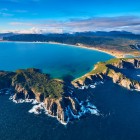
News Stories
Predator Free innovations and what this means for Rakiura
There is a lot to learn from what is happening in the Predator Free movement. Read on for a snapshot of some of the amazing work and innovations happening both locally and globally.

Did you know?
Islands make up just 5.3% of Earth’s land area, and since AD1500, they have lost 75% of all known bird, mammal, amphibian, and reptile species due to extinction. Right now, they are home to 36% of our most critically endangered species.
(Source: Holmes et al., 2019.)
Eradication Projects
Eradication projects like ours are highly complex, and many have long periods of control work before fully committing to a focused intensive eradication effort. The eradication process typically involves five stages: Feasibility, Knock-down, Mop-up, Verify, Biosecurity.
Read more about our predators plus some examples of local and global island eradication projects and a few of the latest trials and scientific innovations.
A New Zealand success story: Rangitoto-Motutapu Islands

Rangitoto Island at dawn. Image: Chris Gin | Creative Commons
3,881 HECTARES COMBINED, UNINHABITED. PREDATOR FREE SINCE 2011.
Predators: 3 species of rats, stoats, mice, feral cats, hedgehogs, rabbits
Methods used: Feasibility study and consultation; Knock-down – aerial poison baiting; Mop-up – trapping and spotlighting; Verify – sign search, dogs, and trapping; Biosecurity – protocols in place.
What did they learn?
- This was a complex project as it involved eradication of 8 species at once.
- The feasibility study allowed proper planning and rapid delivery.
- Lots of time was spent planning to ensure the Auckland stakeholders were happy.
- Intense pressure was maintained at the ‘mop-up’ stage, hunting survivors (particularly cats and hedgehogs). Lots of effort went into verifying eradication.
- Timing is critical – you cannot give predators time to adapt and learn how to avoid bait and traps.
- The project was completed in a shorter time frame and at less cost than anticipated, highlighting the effectiveness of targeting multiple species in one operation.
- One operation also meant less impact and subsequent cost on external stakeholders such as tourism, farming and education camp operators.
- Find out more at https://www.doc.govt.nz/parks-and-recreation/places-to-go/auckland/places/motutapu-island-recreation-reserve/historic-motutapu-island/
The importance of biosecurity
Biosecurity underpins the whole project and must be in place - and working - before an operation commences. Re-invasion risk and post-project biosecurity are key considerations for the feasibility of every eradication project. A strong biosecurity programme, which has been tailored to the specific needs of the individual island, is essential to preventing re-invasion – and avoiding another costly eradication operation in the future.
When biosecurity fails a successful eradication project: Lord Howe Island - 1,455 hectares, inhabited by a population of 350 residents.
Lord Howe Island. Image source: Lord Howe Island Tourism Association.
At the time, this was the largest rodent eradication on a permanently inhabited island.
Predators: rats and mice.
Methods used: Feasibility study and consultation; Preparations – removal of most stock and management for others, waste management facility changes, temporary captive management of two bird species; Knock-down – aerial poison across uninhabited areas and bait stations 10m x 10m grid plus hand-spread baiting through community areas; Mop-up – not required; Verify – sign search and dogs; Biosecurity - dog checks and surveillance on island.
What did they learn?
- It took 17 years from project inception to completion.
- Unfortunately, a reinvasion has put the outcome at risk probably due to insufficient mainland biosecurity prior to goods and people going to the island.
- The intense baiting grid required substantial management resources and a large workforce.
- Care must be taken to avoid compromising eradication protocols in order to gain access to private properties.
- A small percentage of rats in the settlement area avoided bait stations completely. This was attributed to 30+ years of baiting rats with sustained control which resulted in a longer project duration and more expense.
- Eradication operations on inhabited islands are significantly more complex, and in turn, significantly more costly. Managing stock added significant cost and complexity.
- Eradication projects must be community-led, even though this means the project is likely to take years to get to the operational stage.
- Find out more at https://lhirodenteradicationproject.org/
Trials and scientific innovations
Science and technologies are constantly evolving, which is great news for large-scale, complex eradication projects like Predator Free Rakiura. We can learn so much from other island eradication projects, but we can also gain a lot of knowledge from innovative trials that are happening right now, including on Rakiura, such as toxin para-aminopropiophenone (PAPP) to remove stoats and feral cats.
Keep up to date with the latest innovations here.


